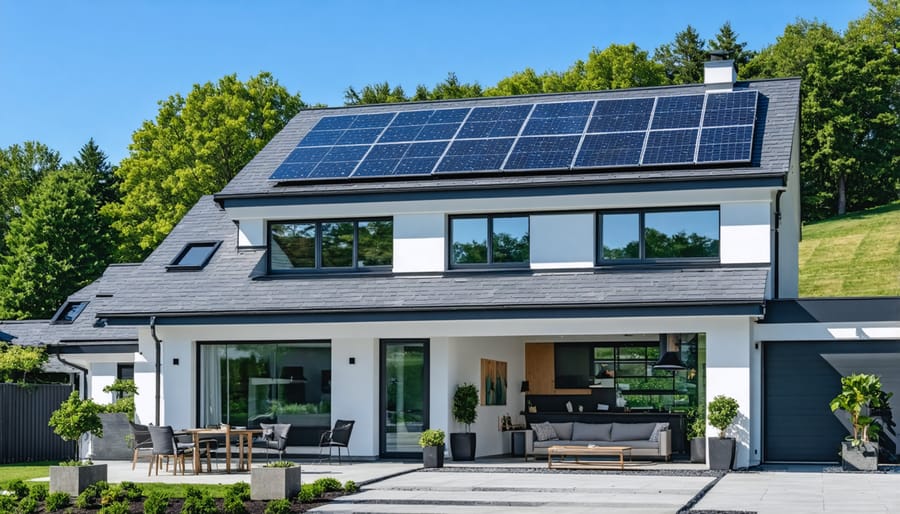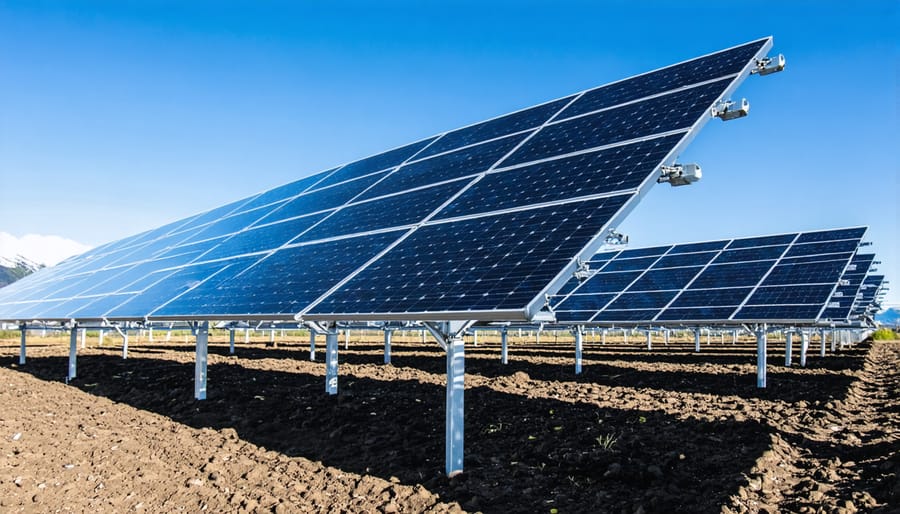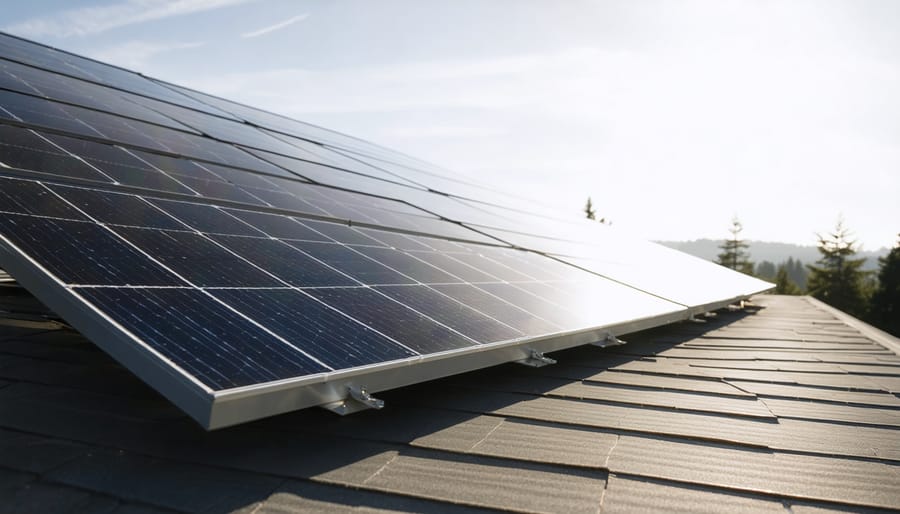Solar panel efficiency has transformed from a mere 6% in the 1950s to over 23% in today’s leading residential installations, revolutionizing how British Columbia powers its homes and businesses. This remarkable advancement not only makes solar energy more accessible but directly impacts the return on investment for property owners across the province.
Modern solar panels now generate nearly four times more electricity from the same amount of sunlight compared to their early counterparts, thanks to breakthrough technologies in photovoltaic cell design and manufacturing processes. For BC homeowners, this translates to smaller required roof spaces and faster energy payback periods, even in our unique Pacific Northwest climate.
The efficiency gains continue to accelerate. While early improvements took decades to achieve single-digit increases, recent innovations have pushed efficiency ratings up by 0.5% annually since 2010. With emerging technologies like perovskite cells and multi-junction designs on the horizon, experts project residential solar efficiency could reach 30% by 2030, making solar an increasingly powerful solution for BC’s clean energy future.
This rapid evolution in solar technology offers BC residents an unprecedented opportunity to participate in the renewable energy revolution while securing long-term energy independence and significant cost savings.
The Evolution of Solar Panel Efficiency
First Generation (1980-2000)
The dawn of commercial solar technology brought hope and innovation to British Columbia’s energy landscape. In the 1980s, the first generation of solar panels achieved efficiency rates between 6% and 15%, converting sunlight into usable electricity through basic silicon cell technology. These early panels, while groundbreaking for their time, were relatively simple in design and required significant roof space to generate meaningful power.
During this period, local pioneers like the Vancouver Public Library installed some of the province’s first solar arrays, demonstrating the technology’s potential despite its limitations. The panels used single-junction silicon cells, which could only capture a specific portion of the solar spectrum, limiting their overall effectiveness.
Throughout the 1990s, manufacturing improvements and research breakthroughs gradually pushed efficiency rates closer to 20%. These advances made solar power increasingly viable for BC homeowners, though installation costs remained high. By the end of this era, solar panels had established themselves as a promising renewable energy solution, setting the stage for the rapid technological developments that would follow.
This foundation period was crucial in developing the robust solar industry we know today, proving that even in our coastal climate, solar power could work effectively.
Modern Breakthroughs (2000-2024)
The past two decades have marked unprecedented progress in solar panel technology, with efficiency rates climbing steadily year after year. In 2000, commercial solar panels typically operated at 12-15% efficiency. Today, homeowners in British Columbia can calculate solar panel efficiency rates exceeding 20-23% for standard installations.
A significant breakthrough came in 2009 when researchers developed multi-junction solar cells, pushing laboratory efficiency past 40%. While these advanced cells were initially limited to specialized applications, their innovations have gradually filtered down to residential solar solutions.
Local success stories highlight these improvements. The Richmond Olympic Oval, upgraded in 2018, showcases modern panels operating at 22% efficiency – nearly double the performance of its original 2010 installation. Similarly, Vancouver’s False Creek Energy Centre demonstrates how newer panels generate 30% more power using the same roof space as systems installed just ten years ago.
Recent developments in perovskite solar cells have shown promise for even greater efficiency gains. These materials, when combined with traditional silicon cells in tandem arrangements, have achieved efficiency rates of 29.8% in real-world applications. For BC homeowners, this translates to smaller installation footprints and better performance during our cloudy winter months.
The most exciting breakthrough comes from bifacial solar panels, which capture sunlight from both sides. These panels have proven particularly effective in snowy BC conditions, where reflected light can boost overall energy production by up to 30% compared to traditional panels.

Key Factors Driving Efficiency Improvements
Material Innovations
The evolution of solar panel materials has played a crucial role in improving efficiency rates over the past decades. Modern panels utilize advanced silicon technologies, with monocrystalline panels leading the way in residential installations across British Columbia. These panels now regularly achieve efficiency rates of 20-22%, a significant improvement from the 12-14% common in the early 2000s.
Recent innovations in photovoltaic materials have introduced perovskite solar cells, which show promise for even higher efficiency rates while potentially reducing manufacturing costs. When combined with solar panel optimization technology, these new materials are pushing the boundaries of what’s possible in solar energy generation.
Local success stories include the installation at Vancouver’s Convention Centre, where high-efficiency panels demonstrate the practical benefits of these material advances. The building’s solar array uses bifacial panels, which capture reflected light on both sides, increasing energy production by up to 30% compared to traditional panels.
Multi-junction cells, though currently more expensive, represent another breakthrough in material science. These cells use multiple layers of different materials to capture a broader spectrum of sunlight, achieving efficiency rates above 40% in laboratory conditions. While not yet commercially viable for most residential installations, this technology shows the potential for future improvements.
Transparent solar materials are also emerging as a promising innovation, particularly for integration into windows and building surfaces. Several pilot projects in BC are already testing these materials, offering a glimpse into how future buildings might generate power through virtually any surface exposed to sunlight.

Manufacturing Processes
The journey to more efficient solar panels has been revolutionized by significant improvements in manufacturing processes. Today’s panels are produced using advanced automation and precision techniques that weren’t possible just a decade ago, resulting in higher quality and more consistent performance.
One of the most notable improvements has been in silicon wafer production. Manufacturers now use diamond-wire sawing technology to create ultra-thin wafers with minimal material waste. This process not only reduces costs but also allows for better light absorption and energy conversion.
Local manufacturers in British Columbia have adopted these cutting-edge techniques, with several facilities implementing automated quality control systems that use artificial intelligence to detect microscopic defects. These systems ensure that each panel meets strict performance standards before installation.
Anti-reflective coating applications have also become more sophisticated. Modern panels receive multiple layers of specialized coatings that capture more sunlight throughout the day, particularly useful for BC’s varying weather conditions. This improvement alone has contributed to a 3-5% increase in panel efficiency.
The introduction of heterojunction cell technology has been another game-changer. This manufacturing process combines different types of silicon layers, creating panels that perform better in cloudy conditions and at higher temperatures – perfect for BC’s coastal climate.
Perhaps most encouraging for homeowners is how these improved processes have made high-efficiency panels more affordable. What once required specialized manufacturing can now be produced at scale, bringing down costs while maintaining excellent quality. Many BC solar installers report that panels manufactured using these advanced techniques typically last longer and maintain their efficiency better over time.
Real-World Performance in BC’s Climate
Coastal vs. Interior Performance
British Columbia’s diverse geography creates distinct conditions that affect solar panel performance across different regions. Our coastal areas, including Vancouver and Victoria, experience milder temperatures and more frequent cloud cover compared to interior regions like Kamloops and Kelowna. While coastal regions might see slightly lower daily energy production due to cloud coverage, the moderate temperatures actually help maintain consistent panel efficiency throughout the year.
Interior regions benefit from higher peak sun hours in BC and clearer skies, potentially generating more power during summer months. However, extreme temperature fluctuations can impact overall efficiency. During peak summer days, when temperatures exceed 30°C, panels may experience a slight decrease in performance, while winter’s cold temperatures generally improve efficiency.
Recent data from installations across BC shows that modern solar panels perform remarkably well in both regions. Coastal installations typically maintain 85-90% efficiency year-round, while interior systems often achieve 90-95% efficiency during optimal conditions. The key difference lies in seasonal variations: coastal systems show more consistent output throughout the year, while interior systems demonstrate higher peaks during summer months but more pronounced dips during winter.
For optimal performance in either region, regular maintenance and proper installation angles are crucial factors that can help maximize energy production regardless of location.

Seasonal Efficiency Patterns
British Columbia experiences distinct seasonal variations that directly impact solar panel efficiency throughout the year. During summer months, particularly June through August, panels typically achieve peak performance with longer daylight hours and more direct sunlight. Vancouver Island and the Lower Mainland can expect efficiency rates of 90-100% during these optimal conditions.
Spring and fall present moderate efficiency levels, with panels operating at 70-85% capacity. While these seasons bring more variable weather patterns, modern solar technology has improved performance during cloudy conditions, ensuring consistent energy production even on overcast days.
Winter months (November through February) show the lowest efficiency rates, typically ranging from 50-65%. However, this reduction is partially offset by the fact that solar panels actually work more efficiently in colder temperatures. The clean, crisp winter air and reflection from snow can even boost performance on clear days.
Interestingly, the Okanagan region, with its semi-arid climate, maintains higher year-round efficiency rates compared to coastal areas, often achieving 15-20% better performance during shoulder seasons. To maximize efficiency across all seasons, local installers recommend tilting panels at a 30-45 degree angle, adjusting based on your specific location within BC.
Future Efficiency Projections
The future of solar panel efficiency in British Columbia looks incredibly promising, with several breakthrough technologies on the horizon. Research labs and manufacturers are working on innovative solutions that could push solar efficiency well beyond current levels, making solar power even more attractive for BC homeowners and businesses.
One of the most exciting developments is the emergence of perovskite solar cells, which could boost efficiency rates to over 30% within the next five years. These cells are cheaper to produce and more flexible than traditional silicon panels, potentially making solar installation more accessible to more BC residents.
Multi-junction cells are another promising technology that could revolutionize solar efficiency. By combining different materials that capture various parts of the light spectrum, these panels could achieve efficiency rates of up to 40% by 2030. While currently expensive, production costs are expected to decrease significantly as manufacturing processes improve.
Bifacial solar panels, which can capture sunlight from both sides, are becoming more common and are particularly well-suited to BC’s snowy conditions. These panels can increase energy yield by 5-30% compared to traditional panels, making them especially effective in areas like the Interior and Northern BC where snow reflection can boost performance.
Local research institutions, including the University of British Columbia and Simon Fraser University, are contributing to these advancements through their sustainable energy programs. Their work focuses on developing cold-weather optimized solar solutions that perform well in BC’s diverse climate conditions.
For BC residents considering solar installation, these upcoming improvements suggest that waiting for better technology might seem tempting. However, current solar panels already offer excellent returns on investment, and upgrading is always an option as new technologies become available. The key is to balance the benefits of immediate energy savings against future efficiency improvements.
Industry experts predict that by 2025, the average solar panel efficiency could reach 24%, making solar an even more compelling option for BC’s clean energy future.
Solar panel technology has come a long way, with efficiency rates more than doubling since the 1960s. Today’s panels typically convert 15-20% of sunlight into electricity, with premium models reaching up to 23%. This steady improvement, combined with falling installation costs and rising energy prices, makes solar power an increasingly attractive option for BC residents and businesses.
As we’ve explored, factors like proper installation, regular maintenance, and optimal positioning can help maximize your panels’ efficiency over their 25-30 year lifespan. In British Columbia’s climate, modern solar installations can generate significant power even during cloudy periods, making them a viable investment for most property owners.
Ready to take the next step? Start by getting a professional assessment of your property’s solar potential. Many local installers offer free consultations and can provide detailed estimates of energy production and cost savings based on your specific location and energy needs. Consider joining local solar community groups to connect with experienced solar owners and learn from their experiences.
Remember to research available rebates and incentives, as these can significantly reduce your initial investment. With proper planning and installation, your solar system can provide reliable, clean energy for decades while contributing to BC’s sustainable energy future. Contact certified solar installers in your area to begin your journey toward energy independence.

